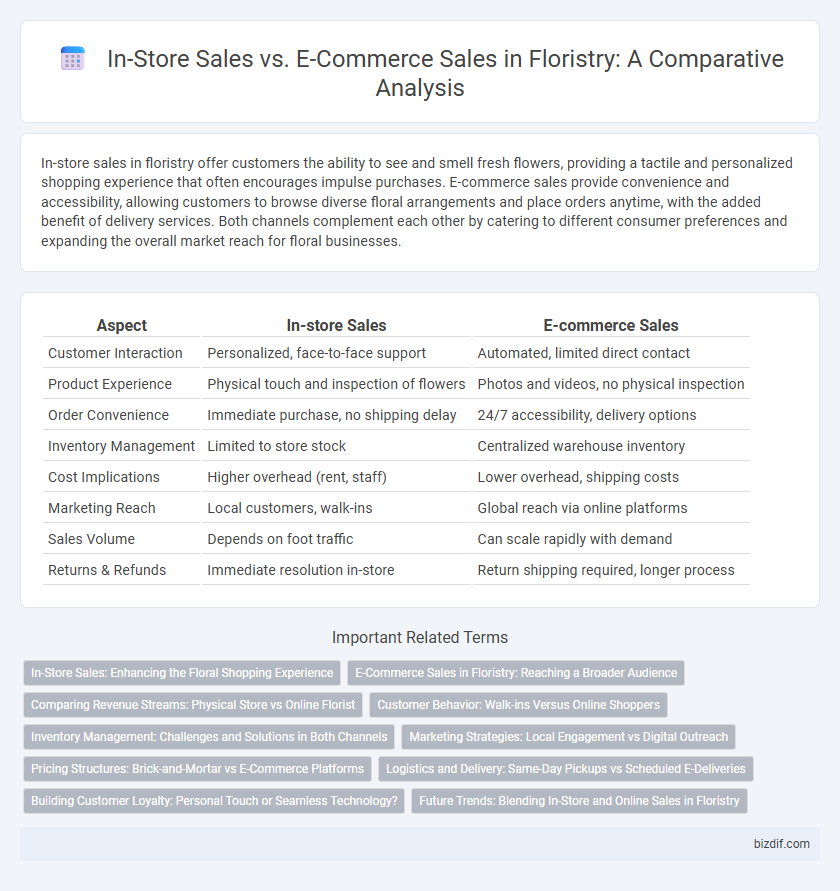In-store sales in floristry offer customers the ability to see and smell fresh flowers, providing a tactile and personalized shopping experience that often encourages impulse purchases. E-commerce sales provide convenience and accessibility, allowing customers to browse diverse floral arrangements and place orders anytime, with the added benefit of delivery services. Both channels complement each other by catering to different consumer preferences and expanding the overall market reach for floral businesses.
Table of Comparison
| Aspect | In-store Sales | E-commerce Sales |
|---|---|---|
| Customer Interaction | Personalized, face-to-face support | Automated, limited direct contact |
| Product Experience | Physical touch and inspection of flowers | Photos and videos, no physical inspection |
| Order Convenience | Immediate purchase, no shipping delay | 24/7 accessibility, delivery options |
| Inventory Management | Limited to store stock | Centralized warehouse inventory |
| Cost Implications | Higher overhead (rent, staff) | Lower overhead, shipping costs |
| Marketing Reach | Local customers, walk-ins | Global reach via online platforms |
| Sales Volume | Depends on foot traffic | Can scale rapidly with demand |
| Returns & Refunds | Immediate resolution in-store | Return shipping required, longer process |
In-Store Sales: Enhancing the Floral Shopping Experience
In-store sales in floristry offer a tactile and sensory experience that e-commerce cannot replicate, allowing customers to personally select fresh flowers and receive expert advice from knowledgeable staff. The physical presence of floral arrangements and the ambiance of a flower shop enhance emotional connections and impulse purchases, driving higher customer satisfaction and loyalty. Strategic store layouts, seasonal displays, and personalized services further optimize the in-store shopping journey, increasing average transaction values.
E-Commerce Sales in Floristry: Reaching a Broader Audience
E-commerce sales in floristry significantly expand market reach by enabling customers to order flowers anytime and anywhere, overcoming geographical limitations of physical stores. The digital platform allows florists to showcase a diverse range of arrangements with detailed descriptions and high-quality images, enhancing customer engagement and purchase confidence. Utilizing targeted online marketing and SEO strategies, florists can attract a broader audience and drive higher conversion rates compared to traditional in-store sales.
Comparing Revenue Streams: Physical Store vs Online Florist
Physical stores generate substantial revenue through direct customer engagement and impulse purchases, often benefiting from high-margin floral arrangements and personalized service. Online florist platforms capture a growing share of sales by offering convenience, broader product selection, and subscription services, driving recurring revenue streams. While physical sales rely heavily on local foot traffic, e-commerce leverages digital marketing and nationwide delivery to expand market reach and increase total revenue.
Customer Behavior: Walk-ins Versus Online Shoppers
Customer behavior in floristry reveals distinct patterns between walk-in shoppers and online buyers. Walk-in customers often seek immediate purchase and personal interaction, favoring tactile experience and expert advice, while online shoppers prioritize convenience, broader selection, and detailed product information. Data shows that in-store purchases peak during holidays and special occasions, whereas e-commerce sales maintain steady growth fueled by mobile shopping trends and digital marketing.
Inventory Management: Challenges and Solutions in Both Channels
Effective inventory management in floristry demands balancing the perishable nature of flowers with fluctuating demand across in-store sales and e-commerce platforms. In-store sales require real-time inventory tracking to minimize waste and ensure fresh stock, while e-commerce involves forecasting algorithms to predict customer preferences and optimize delivery schedules. Integrating advanced inventory management systems that synchronize stock levels between physical and online channels enhances accuracy, reduces spoilage, and streamlines fulfillment processes.
Marketing Strategies: Local Engagement vs Digital Outreach
In-store sales in floristry benefit from local engagement strategies such as community events, personalized customer service, and in-store promotions that foster direct customer relationships. E-commerce sales rely heavily on digital outreach through targeted social media advertising, search engine optimization (SEO), and email marketing to reach a broader audience and drive online purchases. Both marketing approaches optimize customer acquisition by leveraging either physical presence and local brand loyalty or expansive digital platforms for increased convenience and accessibility.
Pricing Structures: Brick-and-Mortar vs E-Commerce Platforms
Brick-and-mortar floristry shops often have higher pricing structures due to overhead costs like rent, utilities, and in-person staffing, impacting bouquet prices directly. E-commerce platforms leverage lower operational expenses and dynamic pricing algorithms, enabling competitive rates and frequent discounts. This pricing flexibility allows online florists to attract price-sensitive customers while brick-and-mortar stores capitalize on personalized service and immediate product availability.
Logistics and Delivery: Same-Day Pickups vs Scheduled E-Deliveries
In-store floristry sales benefit from immediate same-day pickups, offering customers instant access to fresh arrangements and reducing the risk of delivery delays or damage. E-commerce sales rely heavily on scheduled e-deliveries, utilizing advanced logistics networks and temperature-controlled packaging to maintain flower freshness during transit. Efficient coordination between warehouse processing and courier services is crucial to ensure timely delivery and customer satisfaction in online flower sales.
Building Customer Loyalty: Personal Touch or Seamless Technology?
In-store sales in floristry foster customer loyalty through personalized service, expert advice, and sensory experiences that create emotional connections. E-commerce sales leverage seamless technology, offering convenience, customization through AI-driven recommendations, and efficient delivery tracking to enhance customer satisfaction. Balancing personal touch with advanced digital tools is essential for florists aiming to build enduring customer loyalty in a competitive market.
Future Trends: Blending In-Store and Online Sales in Floristry
Future trends in floristry emphasize integrating in-store and e-commerce sales to create a seamless customer experience. Retailers are leveraging augmented reality tools and personalized online consultations to drive online engagement, while incorporating click-and-collect services and same-day delivery to enhance convenience. This blended approach increases customer retention, expands market reach, and optimizes inventory management across both channels.
In-store Sales vs E-commerce Sales Infographic

 bizdif.com
bizdif.com